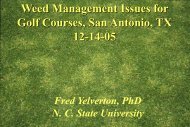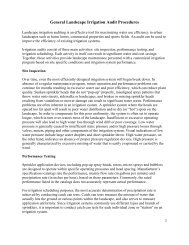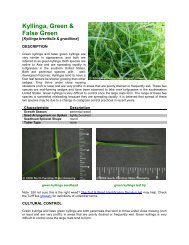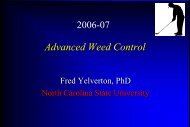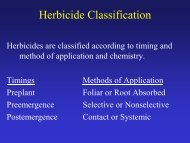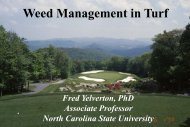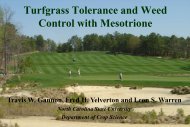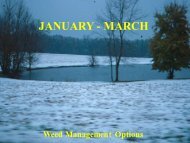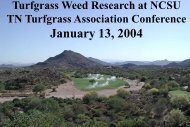Carolina Athletic Fields: - TurfFiles - North Carolina State University
Carolina Athletic Fields: - TurfFiles - North Carolina State University
Carolina Athletic Fields: - TurfFiles - North Carolina State University
- No tags were found...
You also want an ePaper? Increase the reach of your titles
YUMPU automatically turns print PDFs into web optimized ePapers that Google loves.
common bermudagrass include: Blackjack, Blue-Muda,Bradley, Burning Tree, Cheyenne, DelSol, Guymon,Jackpot, LaPaloma, LaPrima (a blend of certified bermudagrasses),Majestic, Mercury, Mirage, Mohawk, Panama,Paradise, Primavera, Primo, Pyramid, Sahara, Savannah,Shangri-La, Soliel, Sonesta, Southern Star, SR 9554,Sultan, Sundance II, Sundevil II, SunStar, Sultan, Sydney,Transcontinental, Yukon, and Yuma.Winter-Kill ConsiderationsFor those sports fields located in the upper piedmontand mountainous regions that are prone to winter lowtemperatureinjury, the choices for bermudagrass becomemore of an issue of survival rather than aesthetics.Midlawn, Midfield, Midiron, Patriot, Quickstand, andVamont are vegetatively propagated bermudagrass selectionswith increased cold tolerance primarily due to theirdeeper and more robust rhizomes. These selections alsotend to retain color longer in fall and green-up sooner inspring, and they are more vigorous in their growth andrecovery from damage or winter-kill. Yukon and Rivieraare seeded bermudagrasses with improved cold toleranceand playing characteristics. In addition, winter-killconsiderations determine which preemergence herbicideto use for crabgrass and goosegrass control. (See weedcontrol section for further details.)Field DrainageReasonable water drainage from a field is important tominimize event cancellations as well as to protect theintegrity of the field. <strong>Fields</strong> built with heavy native soilsdepend primarily on surface drainage to remove excesswater. These fields hold nutrients and have a high waterholdingcapacity, thus, require less fertilizer and water.They also provide good stability, shear strength, and traction.On the downside, most provide inadequate drainageand may compact easily. Perimeter drain lines areneeded to move surface run-off.Sand-based fields can be built essentially flat,not heavily crowned, and have high infiltration rates.Their internal drainage may be designed to move largeamounts of water away quickly. They have minimumcompaction but require more irrigation and fertilizationthan native soils, are usually more expensive to build, andmay be unstable until a mature root zone is established.Minimum Drainage RequirementsFor many high school and local municipal fields, surfacecontouring is the most effective and economical means ofproviding surface drainage. If insufficient sloping of thesurface occurs, water will stand (puddle), saturating thesoil, and the field can be easily compacted and damagedA smaller laser-guided dozer used to spread soil mix. Noteuse of silt fence and plywood to protect sub-surface layers.by traffic. To provide surface drainage, high school footballfields should have a 12-inch crown for sandy soilsand 18 inches for clay soils from center to the sidelineor a 1 to 2 percent slope. Slope at the sideline may bereduced, but the area should not be flat. Surface watermovement in the areas where players stand is importantto prevent puddling.A minimum of four drainage tile lines should beinstalled, one running parallel to the center crown, typicallydown each hash mark, and the other set just off thefield along each sideline. Drain lines are usually 6 incheswide and 12 to 36 inches deep. Two inches of gravel isplaced at the bottom of the lines, a 4-inch perforateddrain line laid on top of this gravel layer, and pea gravel(¼ to ½ inch) or coarse sand is used to fill the trench tograde. The tile should not be laid within 4 inches of thesurface to prevent disruption from future aerifications.The tiles are laid on a continued ½ to 1 percent slope andare connected at their ends to allow water to drain awayfrom the field. Surface catch basins (or culverts) shouldalso be installed between the playing field and both sidelines(stands). These intercept surface drainage from thefield as well as water draining from the spectator stands.At least three (preferably four or more) catch basinsshould be considered for each side of the field. Similardrainage schemes can be developed for soccer, baseball,or other types of sports fields. It is suggested that acontractor be consulted before constructing a baseballfield due to the complexity of removing water from theinfields without flooding dugout areas.ESTABLISHING A NEW FIELDSite PreparationProper preparation prior to planting is critical to ensurethe establishment of a quality turf. Preparation will determinehow quickly the grass becomes established andits long-term maintenance requirements. Soil should be5



